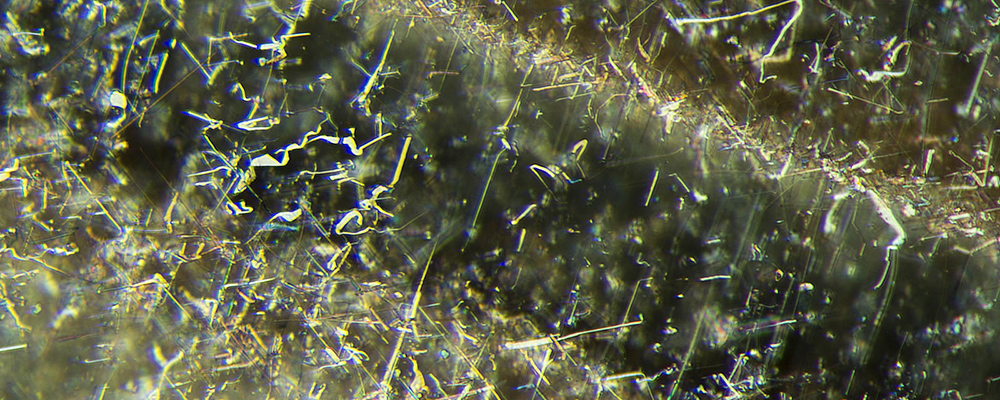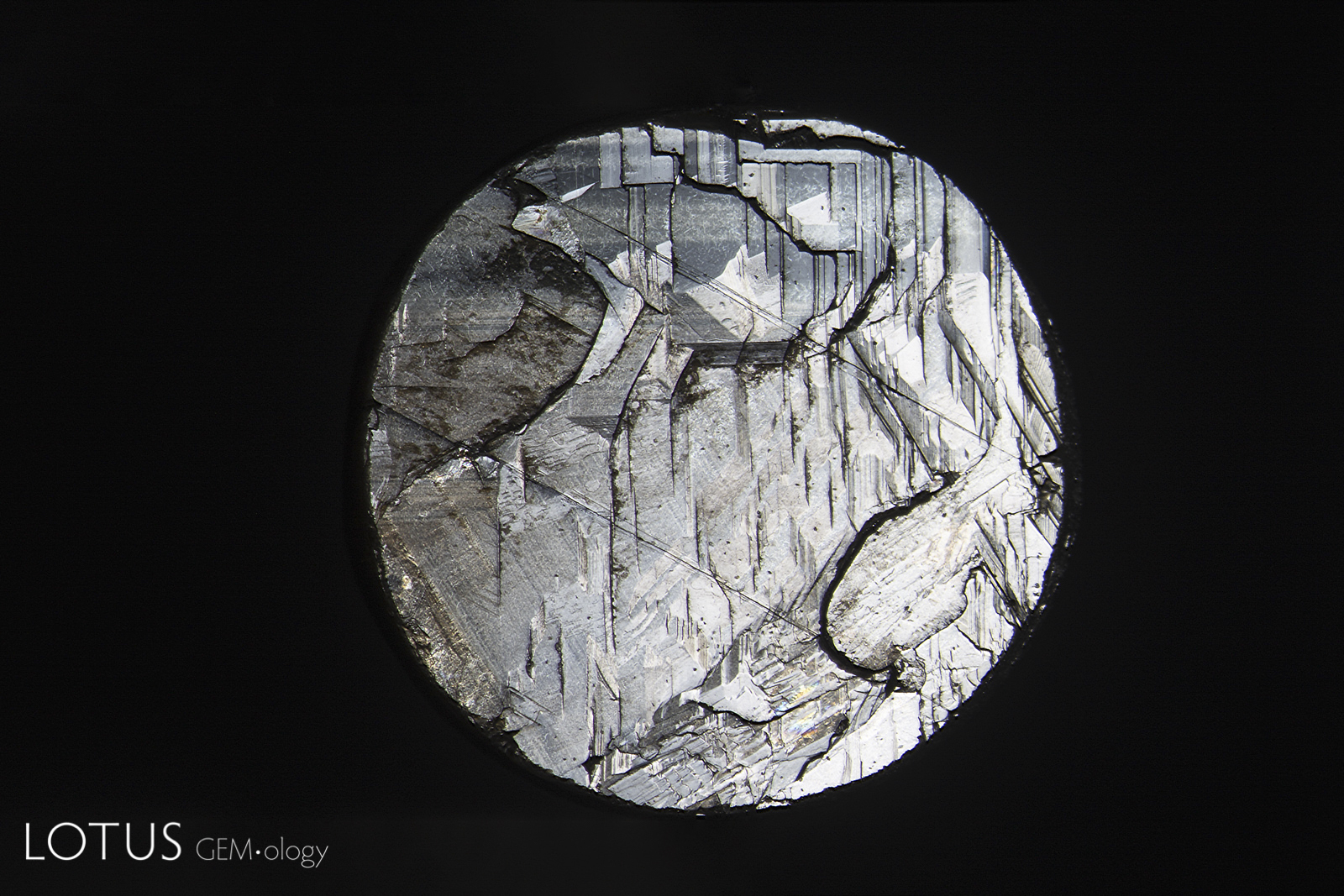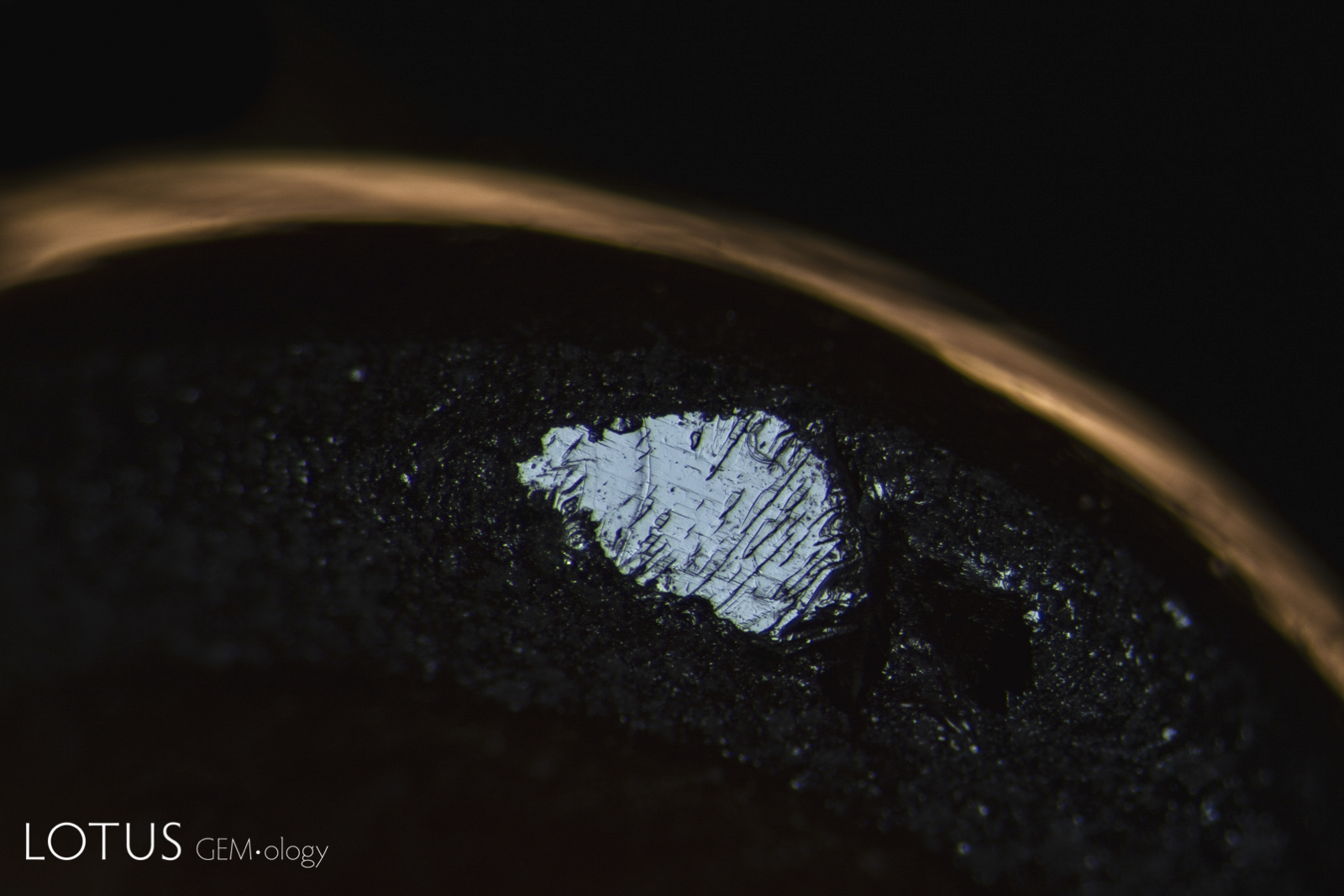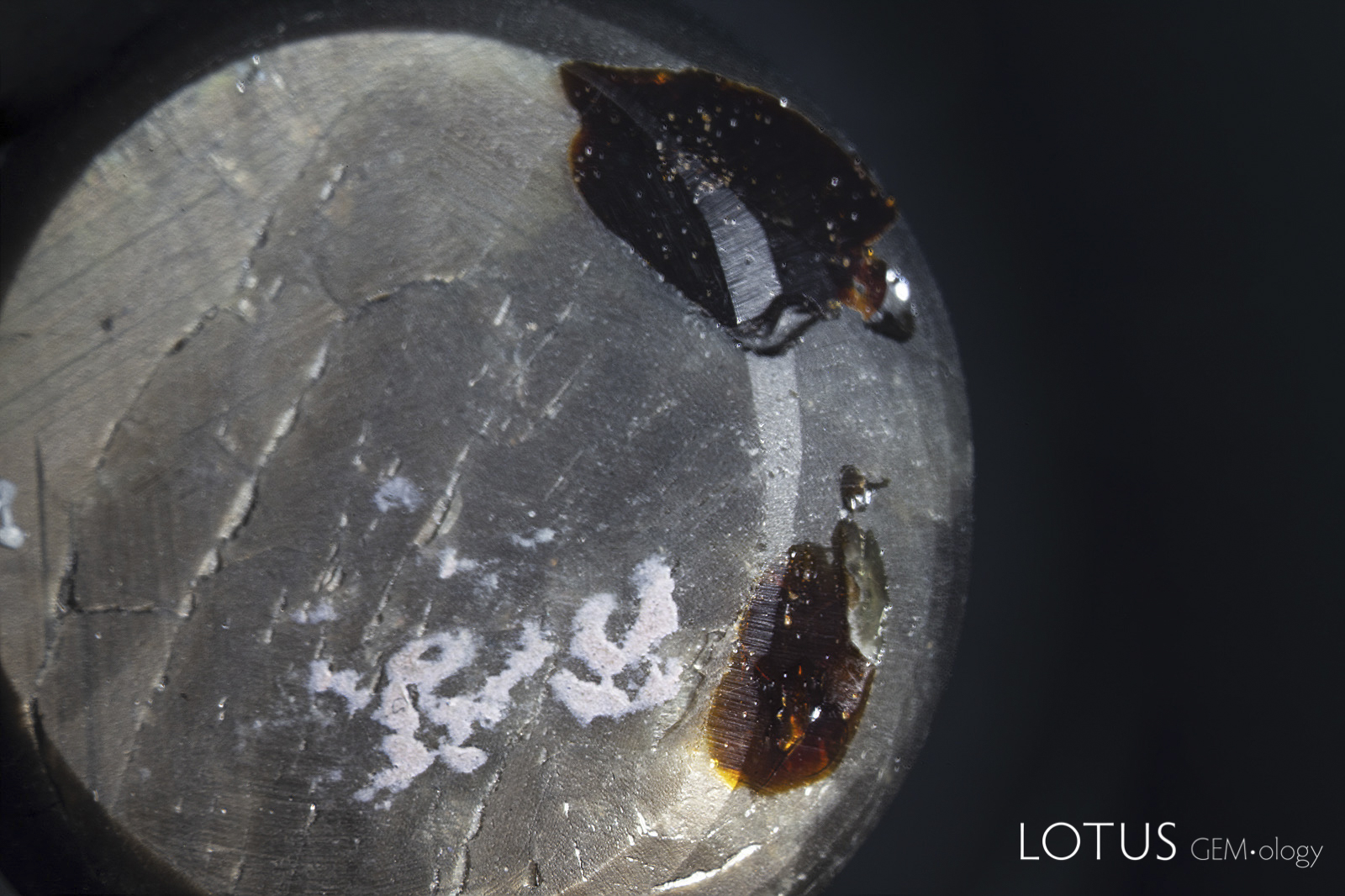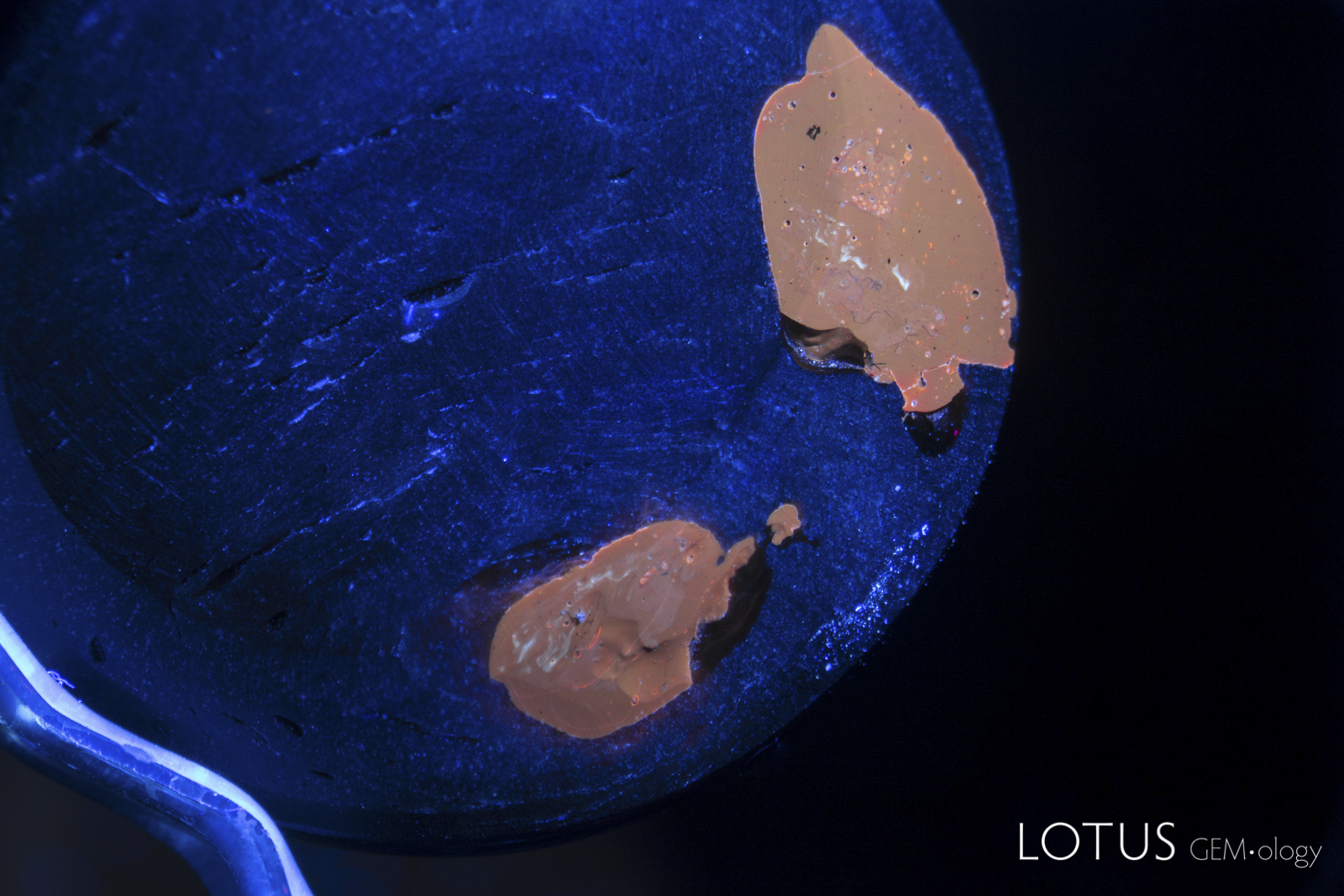A large black star sapphire was brought in for testing. Two large pits on the base were carefully filled with brown dopping varnish. After removal of the varnish with alcohol, it was found that a large portion of the base had been filled with a lead glass.
Black star sapphires primarily come from Kenya, Australia and Thailand. Unlike other star sapphires and rubies, the asterism in these stones generally results from exsolution of ilmenite (FeTiO3) and/or hematite (α-Fe2O3) instead of rutile (TiO2). Rutile and ilmenite/hematite will exsolve in different directions, rutile along the second-order hexagonal prism {1120}, with ilmenite along the first-order hexagonal prism {1010}. If both are present in the same stone, a 12-ray star sapphire results (Figure 1).
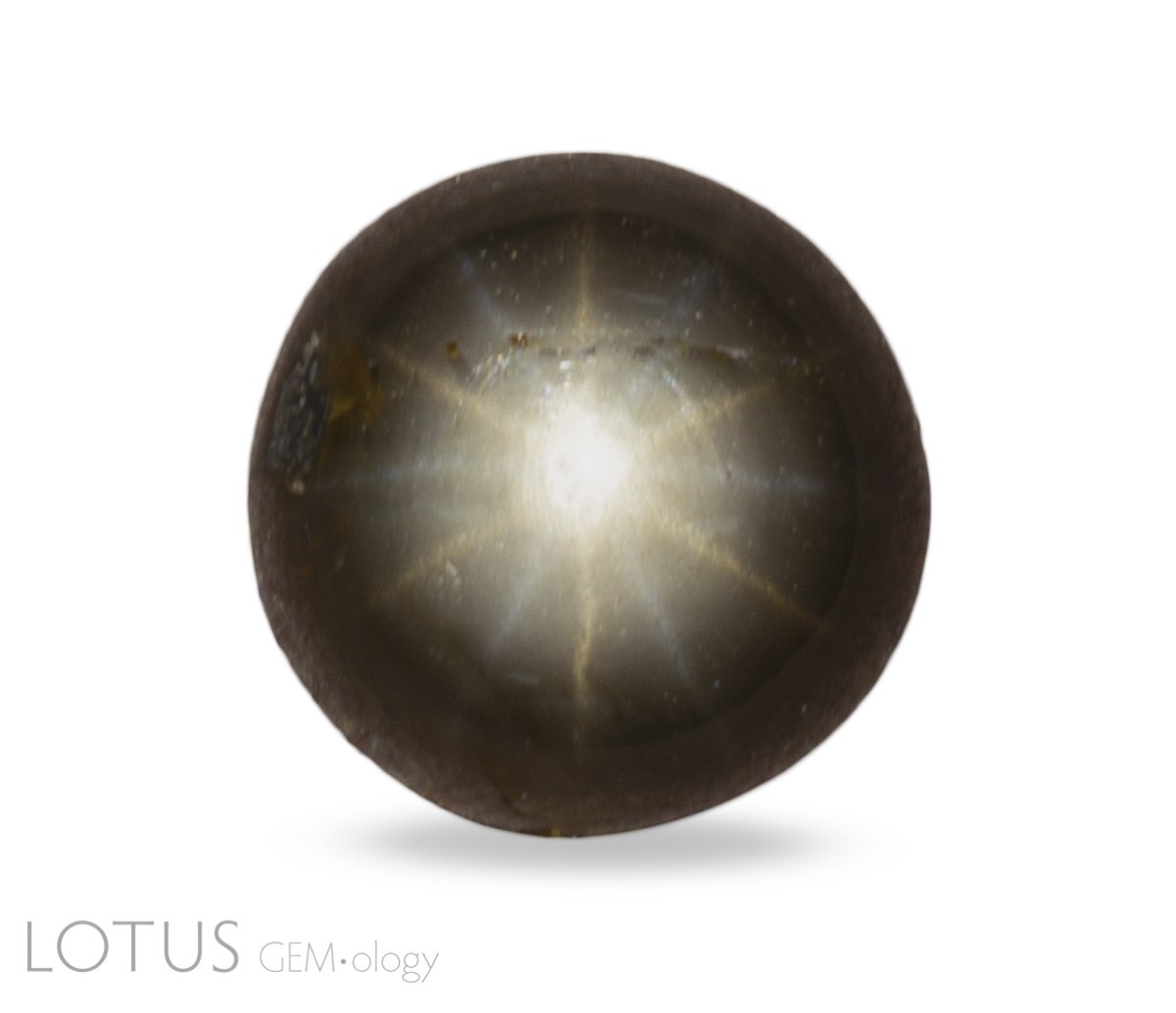 Figure 1. This 12-ray black star sapphire from Chanthaburi, Thailand contains two sets of silk offset 30° from one another. Note that the star created by the rutile is white while the ilmenite/hematite star is slightly yellow. Photo: Chanon Yimkeativong/Lotus Gemology. Click on the photo for a larger image.
Figure 1. This 12-ray black star sapphire from Chanthaburi, Thailand contains two sets of silk offset 30° from one another. Note that the star created by the rutile is white while the ilmenite/hematite star is slightly yellow. Photo: Chanon Yimkeativong/Lotus Gemology. Click on the photo for a larger image.
The ilmenite/hematite crystals tend to be far more "platy" and thus their layers tend to form planes of weakness. Breakage along those planes is termed parting.
Parting differs from cleavage in that it results from structural planes of weakness due to imperfect growth, rather than inherent weakness. One can think of it like this. If an architect creates plans for a building that results in layers of weakness, we would call that cleavage. But if the plans are sound, but the construction crew did a poor job, that would be parting. Parting results from mistakes in growth; cleavage is a function of design weakness.
Shellacked
In Thailand, one often sees cavities on the back of black star sapphires filled in with brown dopping shellac (Figure 3). This is because there are often two different parting planes in the stones. One corresponds to the exsolution of ilmenite/hematite in the plane of the basal pinacoid {0001}. The other corresponds to planes of exsolved boehmite/diaspore along the rhombohedron {1011}.
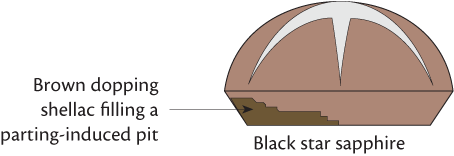 Figure 3. In black star sapphires from Thailand, one often encounters large pits on the back of the stone filled with brown dopping shellac. Illustration: Richard Hughes
Figure 3. In black star sapphires from Thailand, one often encounters large pits on the back of the stone filled with brown dopping shellac. Illustration: Richard Hughes
In May 2020, a client submitted a large 75-carat black-star sapphire for testing (Figure 4). On the back of the stone were two large pits filled with brown dopping shellac (Figure 5, left). Interestingly enough, the shellac fluoresced bright orange under long wave ultraviolet light (365 nm) (Figure 5, right).
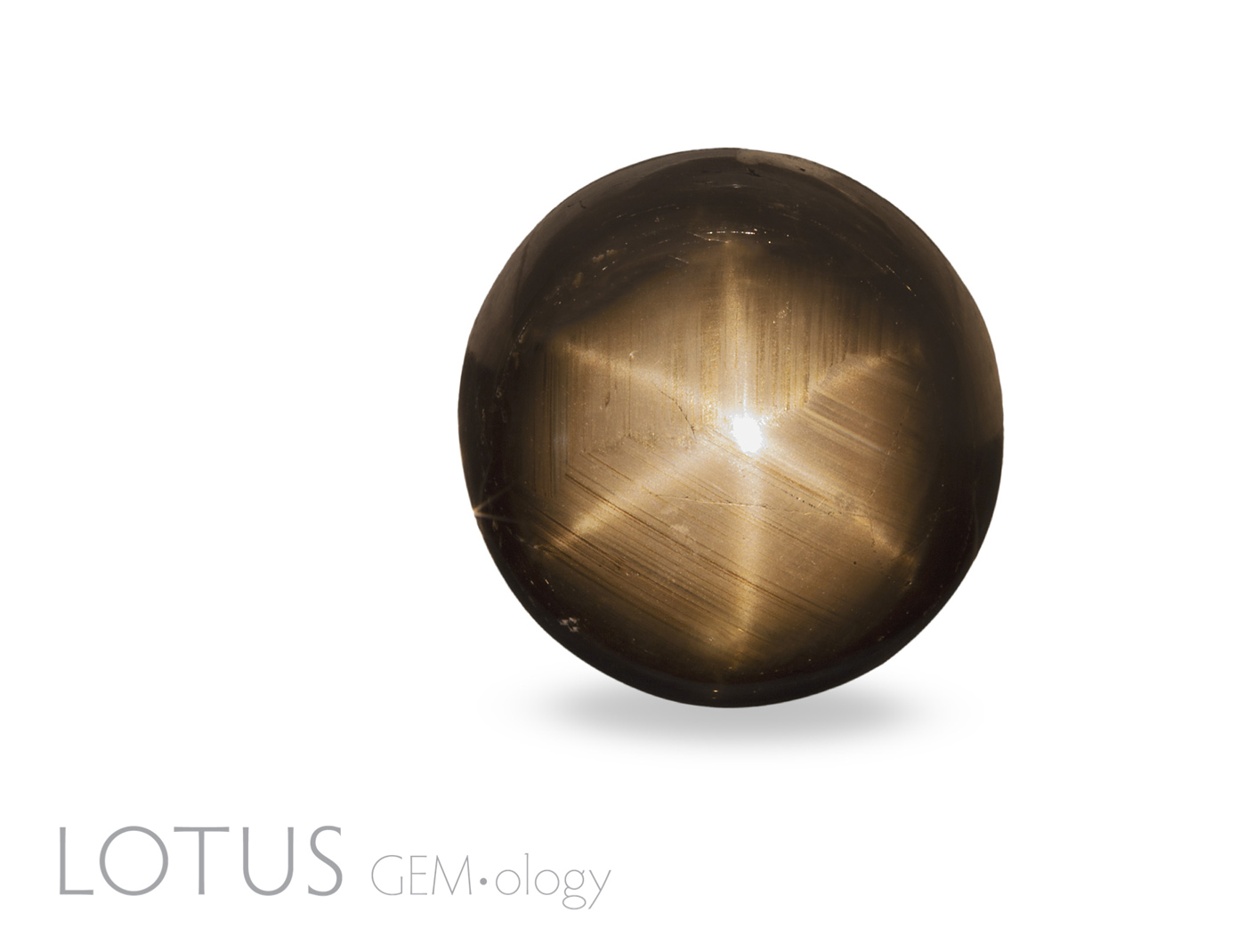 Figure 4. The 75-ct black star sapphire that is the subject of this article. Photo: Wimon Manorotkul
Figure 4. The 75-ct black star sapphire that is the subject of this article. Photo: Wimon Manorotkul
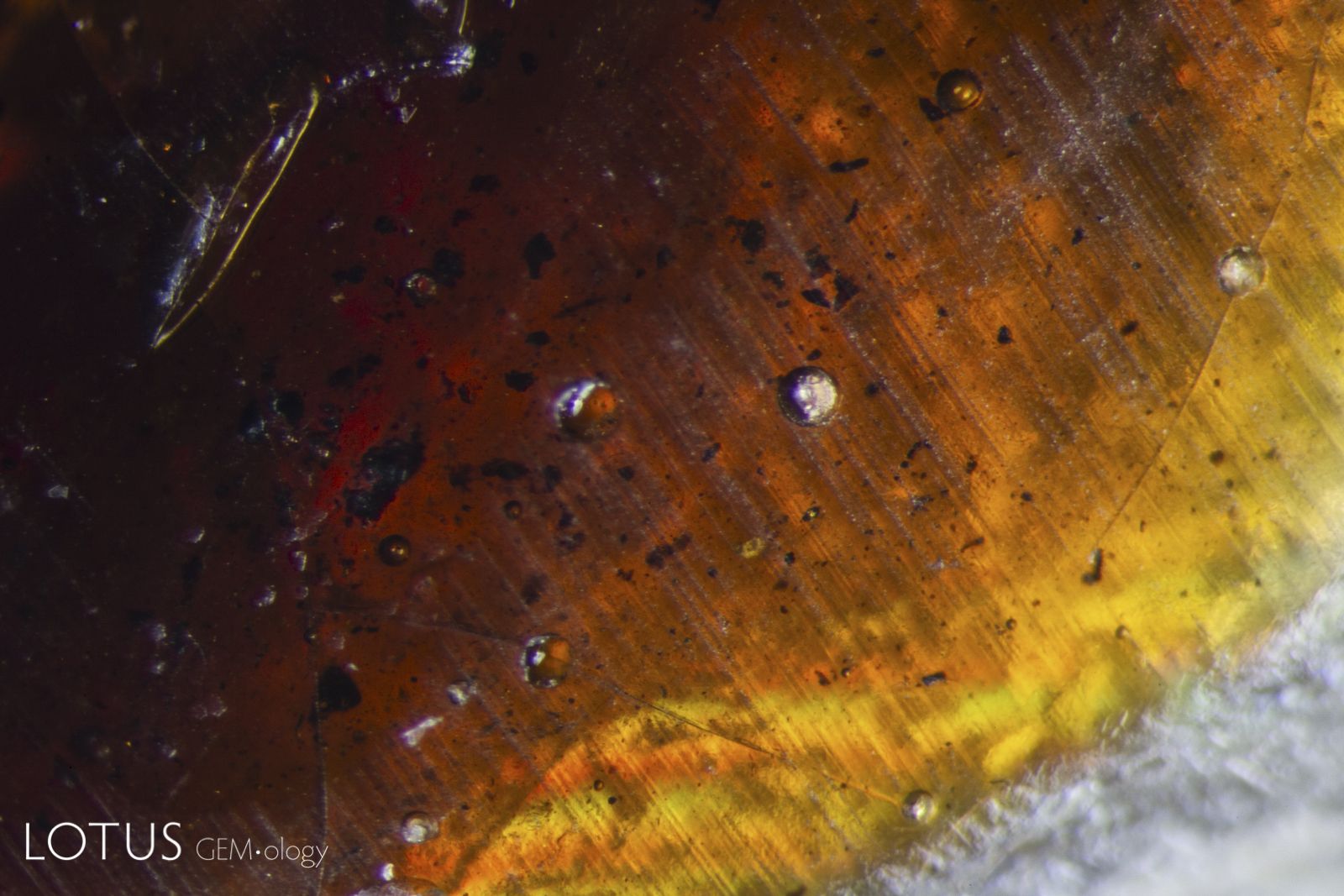 Figure 6. A close-up view of the shellac in the lower pit revealed trapped gas bubbles and black debris. Photo: Richard Hughes; field of view: 5 mm.
Figure 6. A close-up view of the shellac in the lower pit revealed trapped gas bubbles and black debris. Photo: Richard Hughes; field of view: 5 mm.
We informed the client that we would have to issue the report as a treated stone (Lotus Silver) unless the shellac were removed and offered to remove it with alcohol. Following the client's approval, we removed the shellac.
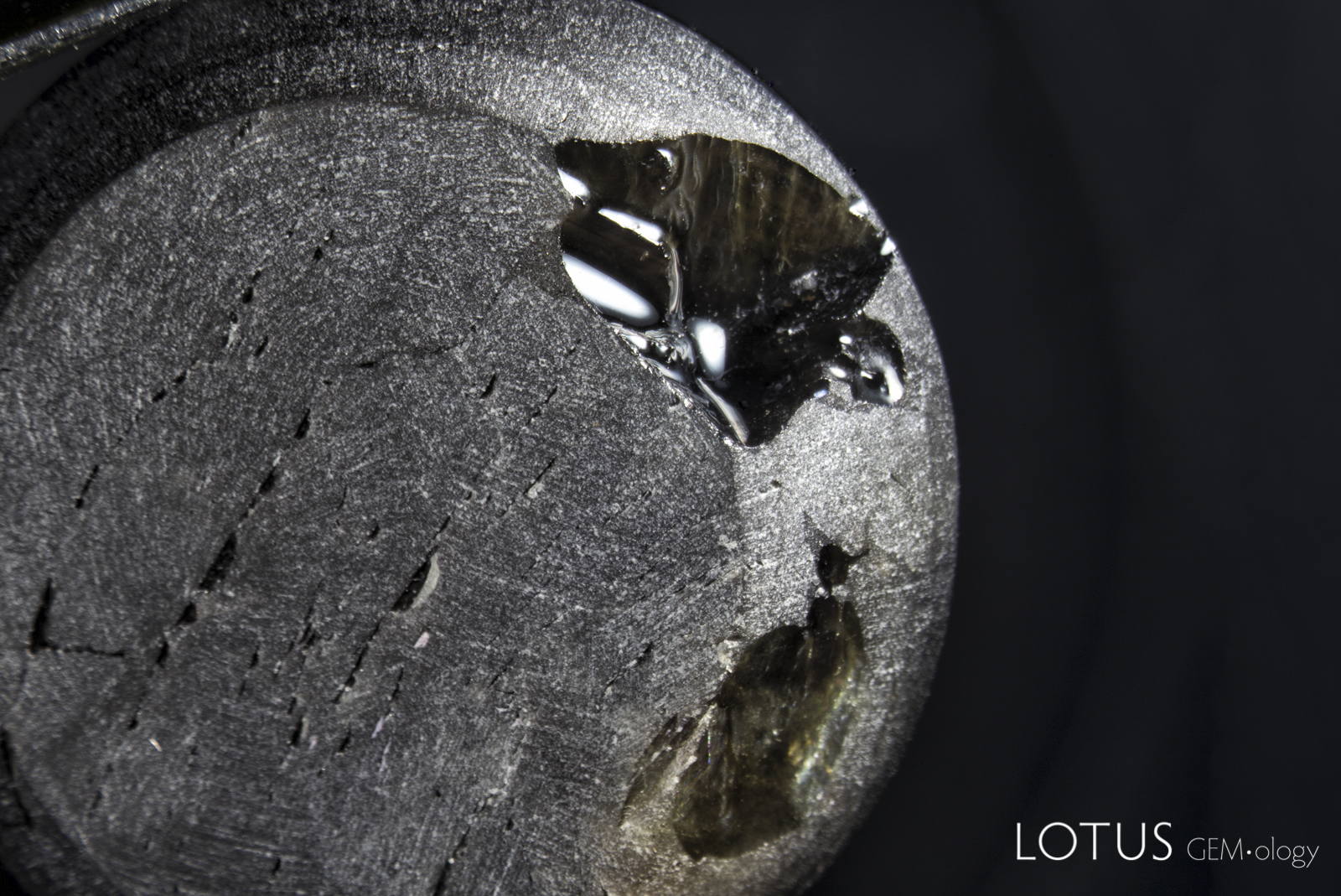 Figure 7. After soaking with alcohol, we were able to completely remove the shellac from the star sapphire. Careful examination of the cavities shows an unusually perfect curved surface, not the type of thing one typically sees on a broken surface of sapphire. Field of view: 30 mm; photo: Richard Hughes.
Figure 7. After soaking with alcohol, we were able to completely remove the shellac from the star sapphire. Careful examination of the cavities shows an unusually perfect curved surface, not the type of thing one typically sees on a broken surface of sapphire. Field of view: 30 mm; photo: Richard Hughes.
After removal of the filler, we noticed an unusual curved area exhibiting an unusual flow-like structure that looked suspiciously like glass (Figure 7). Unfortunately, attempting to get a Raman spectrum on the area was unsuccessful. Careful examination showed what looked like gas bubbles trapped between the glassy material and the sapphire below (Figure 8).
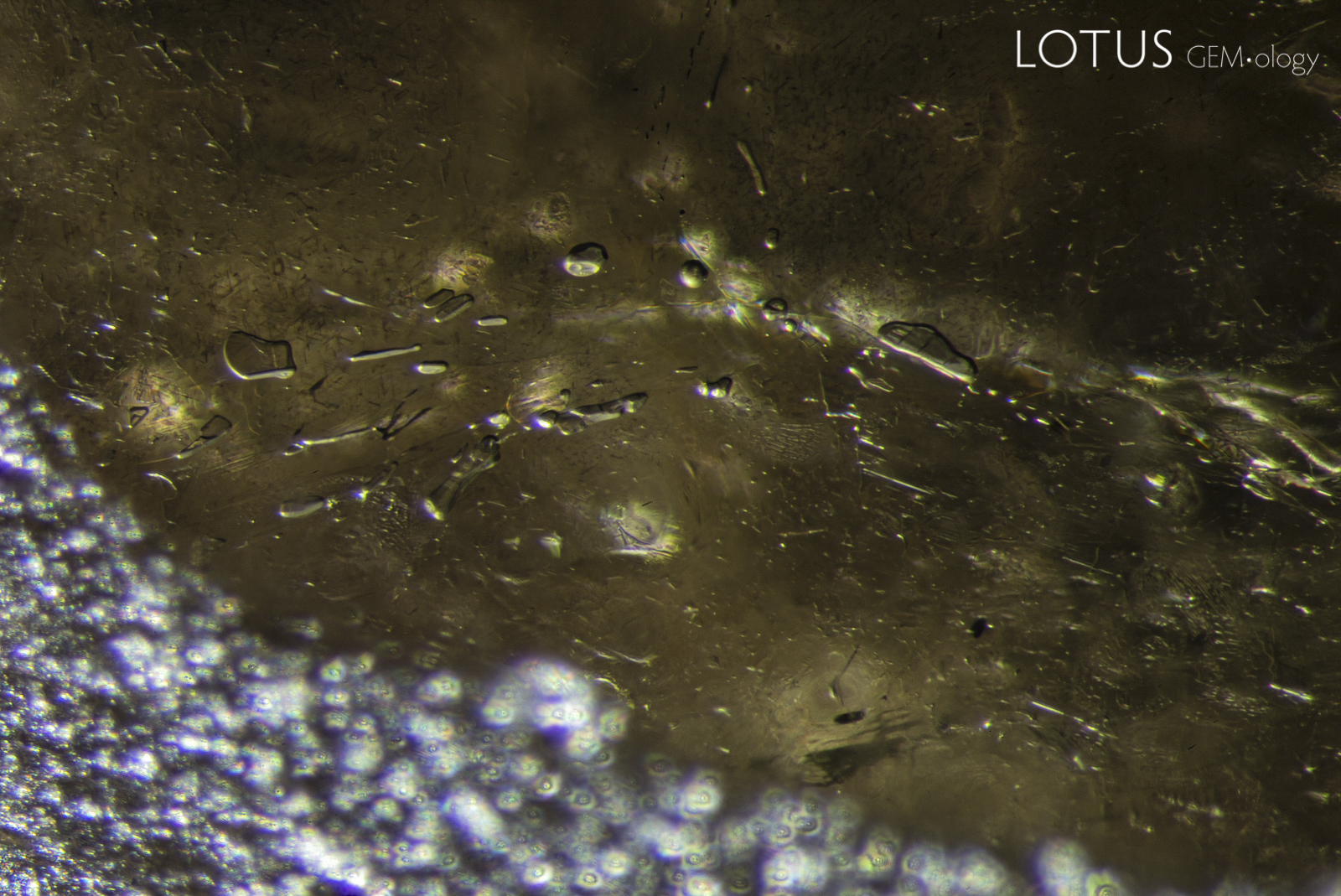 Figure 8. Flattened gas bubbles trapped between the glass filling and the sapphire below. Field of view: 30 mm; photo: E. Billie Hughes.
Figure 8. Flattened gas bubbles trapped between the glass filling and the sapphire below. Field of view: 30 mm; photo: E. Billie Hughes.
Under the microscope, we carefully scratched the surface of the cavity with a Number 7 hardness point (Figure 9), which confirmed that the area could not be corundum.
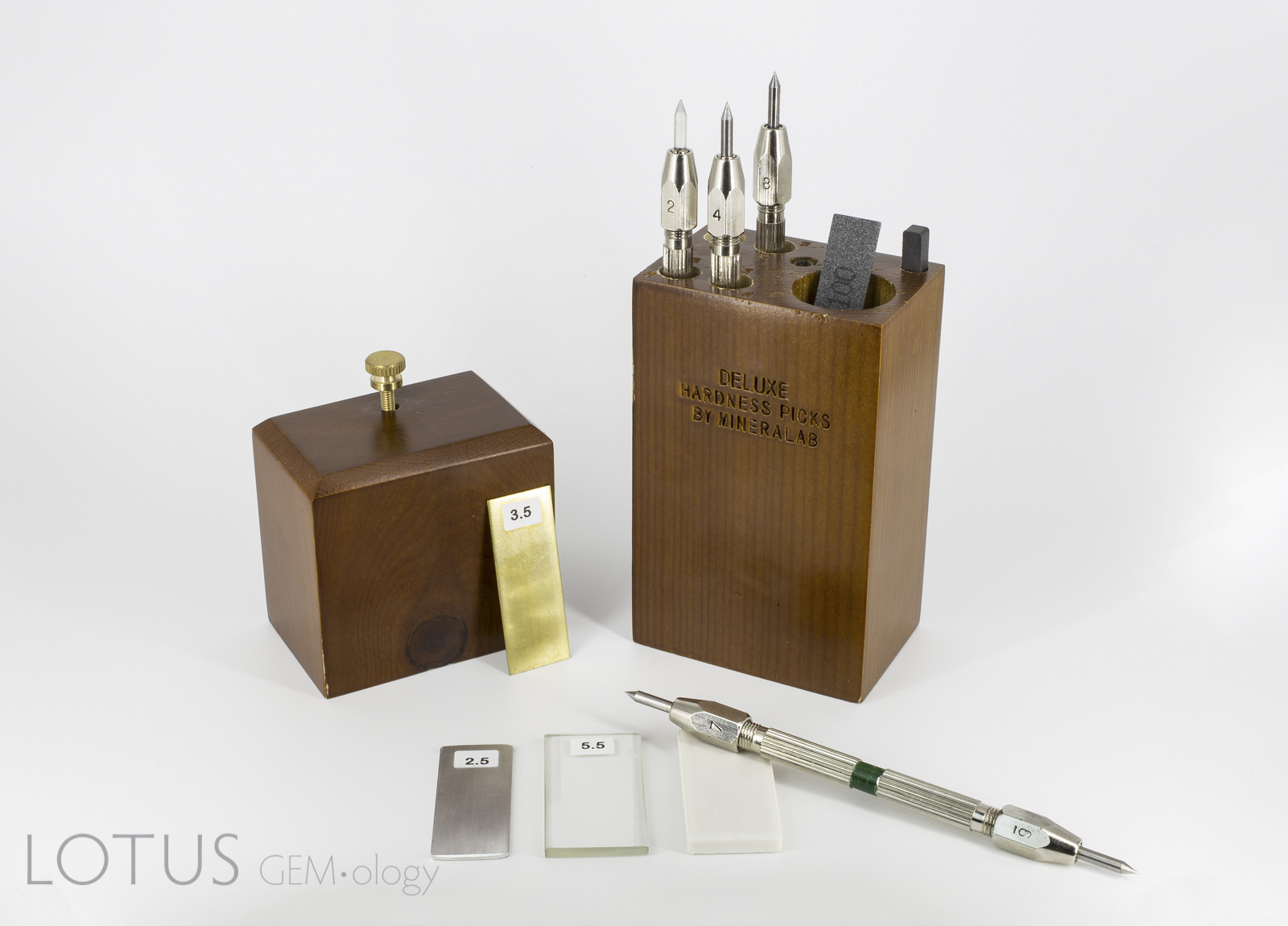 Figure 9. Set of hardness points used by Lotus Gemology. These are easily available for about $110, and include hardness points up to No. 9 on Mohs' Scale. In order to avoid obvious damage, hardness tests should be performed under magnification on inconspicuous locations. Photo: Chanon Yimkeativong/Lotus Gemology.
Figure 9. Set of hardness points used by Lotus Gemology. These are easily available for about $110, and include hardness points up to No. 9 on Mohs' Scale. In order to avoid obvious damage, hardness tests should be performed under magnification on inconspicuous locations. Photo: Chanon Yimkeativong/Lotus Gemology.
Following this, we immersed the gem in methylene iodide. This showed the glassy area to cover roughly two-thirds of the base of the cabochon (Figure 10).
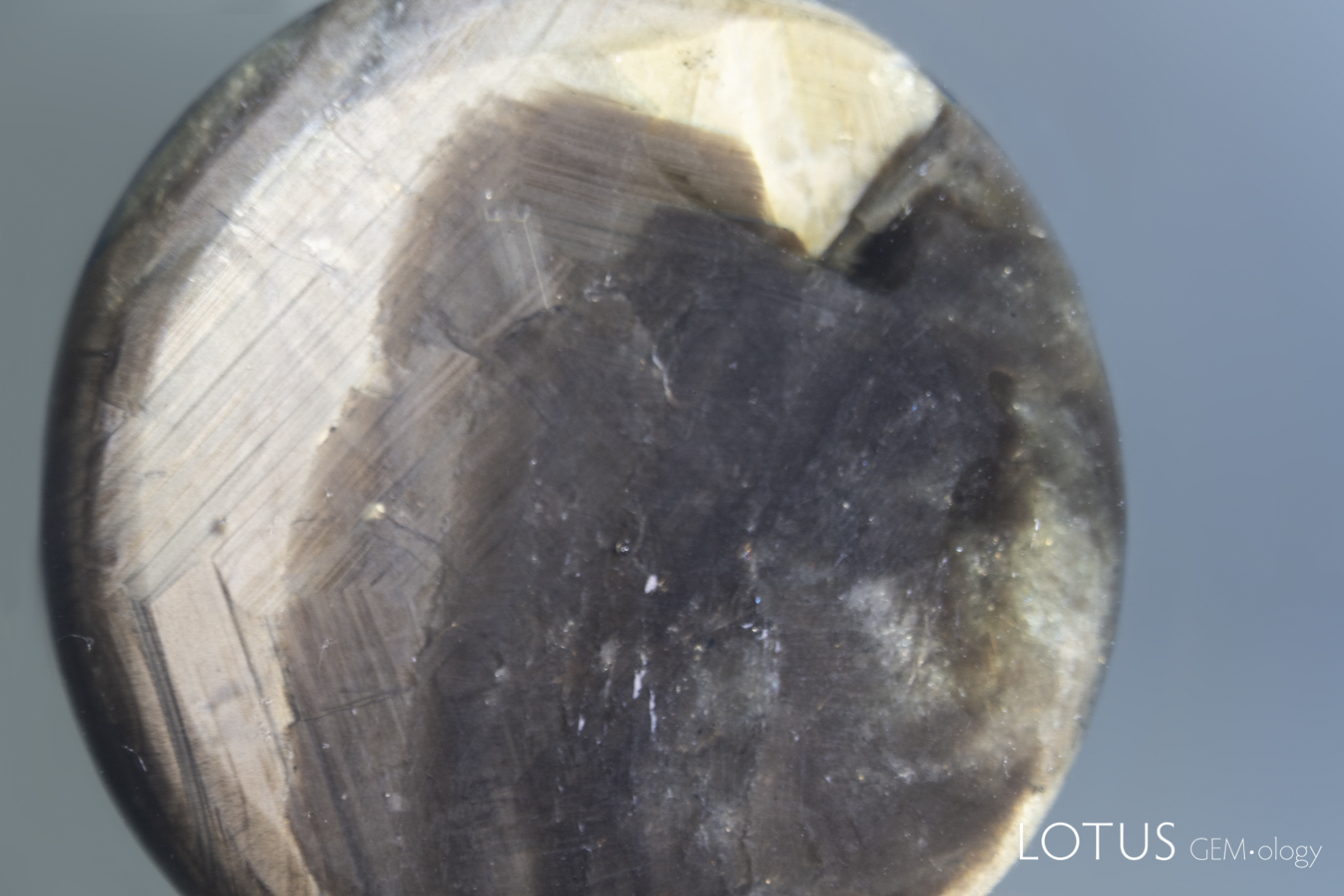 Figure 10. Immersion in methylene diiodomethane (n = 1.741) reveals the extent of the glass filling on the base of the cabochon (the dark area that spreads across a large portion of the base). Field of view: 30 mm; photo: Richard Hughes.
Figure 10. Immersion in methylene diiodomethane (n = 1.741) reveals the extent of the glass filling on the base of the cabochon (the dark area that spreads across a large portion of the base). Field of view: 30 mm; photo: Richard Hughes.
The final test we did was to check the trace element chemistry on the center of the area we suspected to be glass. This revealed a lead (Pb) component of over 3% (Figure 11).
 Figure 11. Energy-dispersive x-ray fluorescence (ED-XRF) testing was performed to determine the trace-element chemistry of the center of the sapphire's base. This revealed a lead (Pb) content of about 3%, confirming the filling to be a lead glass.
Figure 11. Energy-dispersive x-ray fluorescence (ED-XRF) testing was performed to determine the trace-element chemistry of the center of the sapphire's base. This revealed a lead (Pb) content of about 3%, confirming the filling to be a lead glass.
Conclusion
A variety of tests were brought to bear on this specimen, from the simple (hardness) to the high-tech (ED-XRF). The results of these tests revealed a gem that was treated with two different techniques.

About the Authors
Richard W. Hughes is one of the world’s foremost experts on ruby and sapphire. The author of many books and over 170 articles, his writings and photographs have appeared in a diverse range of publications, and he has received numerous industry awards. Co-winner of the 2004 Edward J. Gübelin Most Valuable Article Award from Gems & Gemology magazine, the following year he was awarded a Richard T. Liddicoat Journalism Award from the American Gem Society. In 2010, he received the Antonio C. Bonanno Award for Excellence in Gemology from the Accredited Gemologists Association. The Association Française de Gemmologie (AFG) in 2013 named Richard as one of the Fifty most important figures that have shaped the history of gems since antiquity. In 2016, Richard was awarded a visiting professorship at Shanghai's Tongji University. 2017 saw the publication of Richard and his wife and daughter's Ruby & Sapphire • A Gemologist's Guide, arguably the most complete book ever published on a single gem species and the culmination of four decades of work in gemology. In 2018, Richard was named Photographer of the Year by the Gem-A, recognizing his photo of a jade-trading market in China, while in 2020, he was elected to the board of directors of the Accredited Gemologists Association and was appointed to the editorial review board of Gems & Gemology and The Australian Gemmologist magazine. In 2022, Richard published Jade • A Gemologist's Guide, while 2024 brought Broken Bangle • The Blunder-Besmirched History of Jade Nomenclature. His jade trilogy was completed in 2025 with his translation of Heinrich Fischer's Nephrite and Jadeite.
E. Billie Hughes visited her first gem mine (in Thailand) at age two and by age four had visited three major sapphire localities in Montana. A 2011 graduate of UCLA, she qualified as a Fellow of the Gemmological Association of Great Britain (FGA) in 2013. An award winning photographer and photomicrographer, she has won prizes in the Nikon Small World and Gem-A competitions, among others. Her writing and images have been featured in books, magazines, and online by Forbes, Vogue, National Geographic, and more. In 2019 the Accredited Gemologists Association awarded her their Gemological Research Grant. Billie is a sought-after lecturer and has spoken around the world to groups including Cartier and Van Cleef & Arpels. In 2020 Van Cleef & Arpels’ L’École School of Jewellery Arts staged exhibitions of her photomicrographs in Paris and Hong Kong.
Wimon Manorotkul has been involved with gems and gemology since 1979, as a lab gemologist, instructor and photographer. She is an Accredited Gemologist from Bangkok's Asian Institute of Gemological Sciences and for many years directed their lab. Wimon also qualified as a Fellow (with honors) of the Gemmological Association of Great Britain. A skilled gem photographer, her images have been featured in books and magazines around the world, particularly Ruby & Sapphire: A Collector's Guide, along with Ruby & Sapphire: A Gemologist's Guide and Inside Out | GEM• ology Through Lotus-Colored Glasses. Wimon not only photographs gems, jewelry and mineral specimens, but is also an expert photomicrographer. In 2013, she founded Lotus Gemology with her husband, Richard Hughes, and daughter, E. Billie Hughes.
Notes
Written in May–June 2020. An abbreviated version was published in Gems & Gemology (Fall 2020, pp. 442–443) (Fall 2020, pp. 442–443).
References
- Bui, T.N. (2018) Peculiar trapiche-like pattern in a gold-sheen sapphire. Journal of Gemmology, Vol. 36, No. 4, pp. 289–291; RWHL.
- Bui, T.N., Deliousi, K., Corte, K., de and Gauthier, J.-P. (2016) Star sapphire showing a variable number of rays. Journal of Gemmology, Vol. 35, No. 3, July, pp. 197–199; RWHL.
- Bui, T.N., Deliousi, K., Malik, T.K. and Corte, K., de (2015) From exsolution to 'gold sheen': A new variety of corundum. Journal of Gemmology, Vol. 34, No. 8, October, pp. 678–691; RWHL*.
- Moon, A.R. and Phillips, M.R. (1984) An electron microscope study of exsolved phases in natural black Australian sapphire. Micron and Microscopica Acta, Vol. 15, No. 3, pp. 143–146; RWHL.
- White, J.S. (1979) Boehmite exsolution in corundum. American Mineralogist, Vol. 64, Nos. 11–12, pp. 1300–1302; RWHL*.


